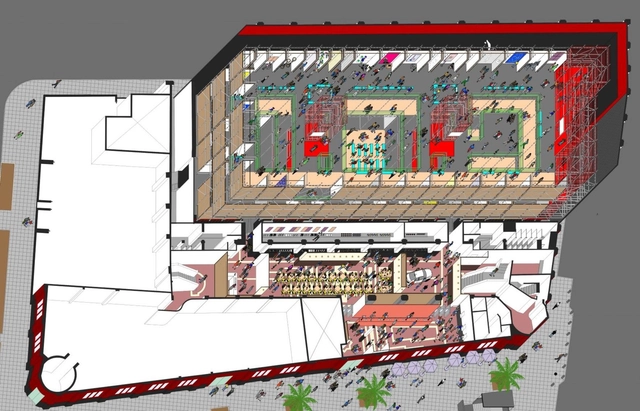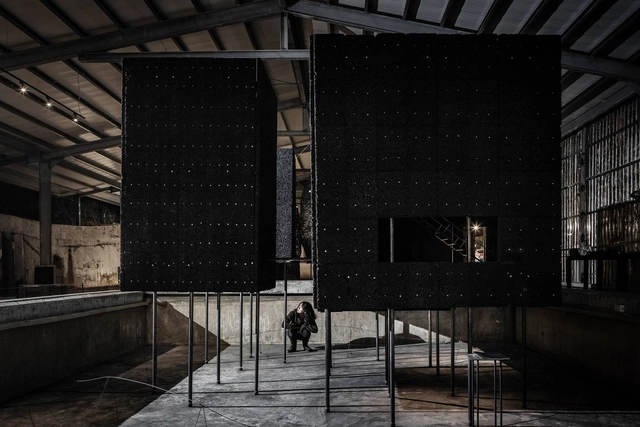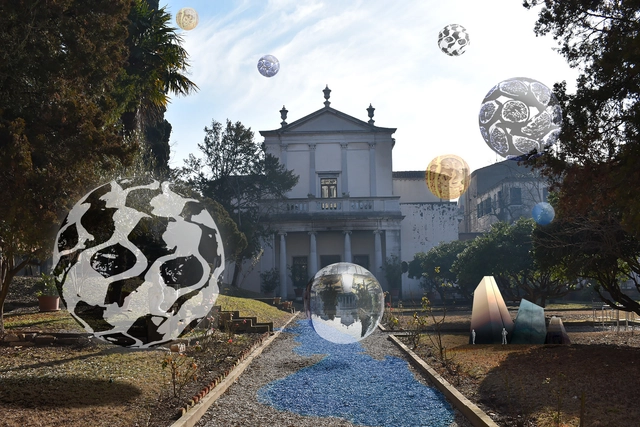Produce personalized presentation boards that distill complex concepts into simple visual representations with a few helpful tools and effects.
Architecture News
How to Create Architectural Presentation Boards
Winners of the 2021 Architectural League Prize for Young Architects + Designers Announced

The Architectural League of New York has announced the 6 winners of 2021 Prize for Young Architects + Designers Awards, the North American annual competition that celebrates the works of young architects and designers who have completed their bachelor’s or master’s degree within the last ten years. This year's theme was Housekeeping, which asked participants to explore how the domestic settings have changed over the past couple of years, changing the definition of "ideal residence".
Serbian Pavilion at the 2021 Venice Biennale Reflects on the Present and Future of Industrial Cities

The Serbian contribution to the 17th Venice Architecture Biennale explores the connection between a city's economy and its urban structure -that the curatorial team defines as the life-work relationship- investigating the prospective futures of mono-functional industrial cities. Titled 8th Kilometer and developed by MuBGD, the exhibition uses the mining town of Bor, located in eastern Serbia, as a study case for how economic activities have not only shaped the urban environment but the forms of collectivity connected to it.
A Sneak Peek of Expo 2020 Dubai

With less than half a year to go until the opening, Expo 2020 Dubai released a series of images of the venues hosting the event, which intends to bring together 192 national pavilions, as well as businesses and educational institutions. As the program was delayed for a year due to the coronavirus pandemic, the world expo site is mainly complete, awaiting its opening on October 1st.
The Taiwan Intervention at the 2021 Venice Biennale's Collateral Events Unpacks the Impact of Migration

Entitled Primitive Migration from/to Taiwan, the National Taiwan Museum of Fine Arts (NTMoFA) and curatorial teams Divooe Zein Architects and Double-Grass International Co., organized an immersive exhibition for the Biennale Architettura 2021. Taiwan’s Collateral Event for the 17th International Architecture Exhibition of La Biennale di Venezia will run from 22 May to 21 November 2021 at Palazzo delle Prigioni.
Armenian Pavilion at the 2021 Venice Biennale Highlights the Diasporic Communities

Titled "HYBRIDITY", the Armenian Pavilion at the 17th International Architecture Exhibition - La Biennale di Venezia, allows visitors to step into the Armenian experience of coexisting in countries across the globe. Curated by Allen Sayegh (Vosguerichian), the exhibition will be on display at Palazzo Ca' Zenobio from August 28th until November 21st, 2021.
Studio One Eleven and Adjaye Associates Transform Downtown LA Industrial Site

Adjaye Associates and Studio One Eleven, along with Continuum Partners will transform an industrial facility in downtown Los Angeles into a dynamic mixed-use master plan of residential, commercial, hospitality, and retail facilities. Titled Fourth & Central, the project proposes ten buildings, ranging in heights, design, and functions, transforming the area into a pedestrian-oriented community. The project, which is expected to break ground in 2024, will reflect the area's dynamic character with uniquely designed buildings that compliment the neighboring Arts District and Little Tokyo neighborhoods.
The Croatian Pavilion for the 2021 Venice Biennale Imagines New Spaces of Togetherness

The Croatian Pavilion for the 17th Venice Architecture Biennale explores how repurposing architectural elements reshapes the individual’s relationship with space and constructs a new place of encounter. Titled Togetherness / Togetherless, the project curated by Idis Turato is a spatial composition of ready-made elements, which are given new meanings and functions, developing a new perspective on architectural space and enabling a temporary community.
UN Studio to Design Congress and Conference Centre in the Netherlands

UNStudio is part of the consortium that recently won the competition for a new congress and conference centre in the Netherlands, a project intended to further establish the Brainport Eindhoven region as one of Europe’s leading technology hubs. The Elysion Congress Centre expands an exiting, similarly programmed venue, striving for low impact on the surroundings while incorporating numerous sustainable features.
"Utopias of Common Life": Brazil's Official Participation in the Venice Biennale 2021

Entitled utopias of common life, Brazil's official participation in the 17th Bienalle Architettura 2021 is curated by the collaborative studio Arquitetos Associados and the visual designer Henrique Penha. The exhibition at the Brazilian Pavilion in the Giardini, in Venice, begins by mapping utopias that exist on Brazilian soil, from the Guarani world vision of a Land Without Evil to contemporary times, highlighting a few singular moments among them.
Conceived before the Covid-19 pandemic, which has temporarily suspended the possibility of physical proximity in a large part of the world, the proposal gains new meanings in the current context and dialogues with the overall theme, by curator Hashim Sarkis: How Will We Live Together?
The Singapore Pavilion at the 2021 Venice Biennale Explores the Architecture of Relationships

Titled "To Gather: the Architecture of Relationships", the Singapore pavilion at the 17th International Architecture Exhibition - La Biennale di Venezia, displays different ways the Singaporeans share public spaces. Curated by the National University of Singapore (NUS), the pavilion will be on display from May 22nd to November 21st, 2021.
Sou Fujimoto Architects Design "Garden in a Box" as Shenzhen's New Exhibition Hall

Japanese studio Sou Fujimoto Architects alongside Chinese office Donghua Chen Studio have designed a large scale exhibition complex in the heart of Futian District. The Shenzhen Reform and Opening-up Exhibition Hall adopts the city's characteristics as a contemporary entrepreneurial hub, welcoming innovative international businesses in a garden-inspired structure wrapped with white perforated facades. The design proposal was the winning entry of an international competition in Futian, and will be a part of the Shenzhen Ten Cultural Facilities of New Era promoted by the Municipal Government, once completed.
7N Architects Selected by Network Rail and RIBA to Shape Britain's Future Railways

RIBA and Network Rail recently announced the winner of the Re-imagining Railways design competition, which invited architects, engineers and designers to rethink small and medium-sized train stations to improve the travel experience. The winning design, signed by Edinburgh-based architectural practice 7N Architects, features a reinterpreted clock tower serving as a local landmark and a modular station layout that can be adapted to a variety of sites.
Mass Timber: Shattering the Myth of Code Exceptions

Structural timber is in the midst of a renaissance; an ironic trend given that timber is arguably the most ancient of building materials. But new innovations in structural timber design have inspired a range of boundary-pushing plans for the age-old material, including everything from bridges to skyscrapers. Even more crucially, these designs are on the path to realization, acceding to building codes that many (mistakenly) view as restrictive to the point of impossibility.
The timber structures of today aren't just breaking records - they're doing it without breaking the rules.
The Japanese Pavilion at the 2021 Venice Biennale Addresses Mass Consumption and Reusability

For this year's edition of the Venice Biennale, the Japan Pavilion invites visitors to reflect on the movement of goods fuelling mass consumption and rethink sustainability and reuse in architecture. Titled Co-ownership of Action: Trajectories of Elements, the project curated by Kadowaki Kozo involves dismantling an old wooden Japanese house and transporting it to Venice to be reconstructed in a new configuration with the addition of modern materials. The exhibition exemplifies how old materials could be given an entirely new existence by putting the current movement of goods in the service of reuse rather than consumption.
Art Gensler, Founder of Gensler Passes Away at 85

Art Gensler, the founder of one of the largest architecture businesses in the world, Gensler, has passed away at 85, as reported by the company’s Instagram Account. The architect and businessman founded Gensler back in 1965, in San Francisco, and in his 65 years of career, he managed to turn his practice into one of the leading worldwide firms with 50 locations across Asia, Europe, Australia, the Middle East, and the Americas.
Chinese Pavilion at the 2021 Venice Biennale Reimagines Traditional Multi-family Courtyards

Titled "Yuan-er, a Courtyard-ology: From the Mega to the Micro", the Chinese pavilion at the 17th International Architecture Exhibition – La Biennale di Venezia answers the question of how architecture can contribute to equality, connectivity and unity by resorting to familiar Chinese residential typologies. Curated by Zhang Li, the pavilion will be on display from May 22nd to November 21st, 2021.
MAD Architects Unveil Canal-Inspired Design of the Jiaxing Civic Center

Led by Ma Yansong, MAD Architects have released their design for the Jiaxing Civic Center, a project that explores the relationship between city, nature, and people. The proposed center will be a new place of attraction for children, adults, and seniors, sitting on the city's central axis and surrounded by its South Lake, Haiyan River, and Central Park. The master plan will house three venues: the Science and Technology Museum, the Women and Children Activity Center, and the Youth Activity Center, all organized around a central green open space. The firm's latest public project in Jiaxing City, which is expected to be complete by the end of 2023, comes shortly after they unveiled their design for the Jiaxing Train Station earlier this year.
Philadelphia Museum Opens after Extensive Renovation Project led by Frank Gehry

Philadelphia Museum of Art opened to the public earlier this month after completing an extensive four-year renovation and interior expansion project led by Frank Gehry. The intervention, dubbed the Core Project, focused on renewing the museum's infrastructure, creating galleries and public spaces while leaving the 1928 exterior untouched. The culmination of two decades of planning and design, the project led by the renowned architect creates a compelling vision for the future of the museum while honouring the landmark building.
Beyond Straight Lines: Curves in Brazilian Houses

Modern architecture, in its early days, was based on innovative technologies of construction and a rejection of ornament, which established the use of straight lines in building design. However, thanks to the plasticity of concrete and other materials, new patterns began to emerge, resulting in more organic and curvy lines.
Italian Pavilion Reflects on the Resiliency of Local Communities in the Face of Climate Change

The Italian Pavilion for the 17th Venice Architecture Biennale explores the capabilities for transformation and adaptation of Italian communities in an attempt to define tangible solutions to current global challenges. Titled "Resilient Communities", the exhibition curated by Alessandro Melis presents Italian research and innovation across many fields, exploring ideas for improving the conditions of the built environment and addressing climate change, with the hope of defining the building blocks for a sustainable future.
Germane Barnes Wins 2021 Wheelwright Prize

Germane Barnes has won the 2021 Wheelwright Prize from Harvard University Graduate School of Design. The $100,000 prize will fund two years of travel and research for Barnes’s proposal Anatomical Transformations in Classical Architecture, an examination of classical Roman and Italian architecture through the lens of non-white constructors. Barnes will study how spaces have been transformed through the material contributions of the African Diaspora while creating new possibilities within investigations of Blackness.

























































































